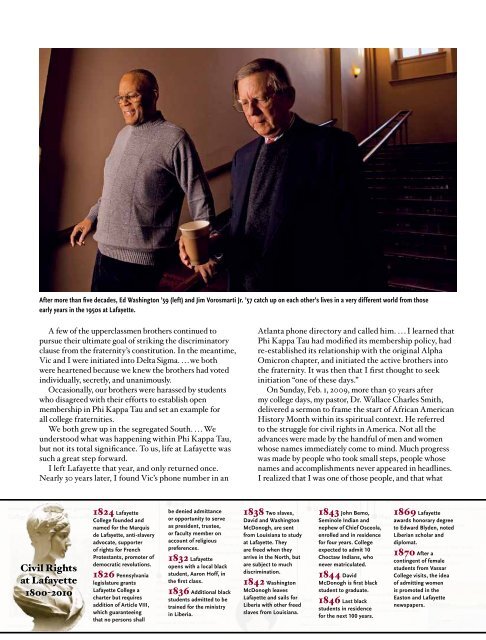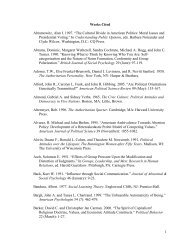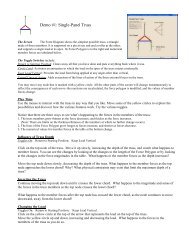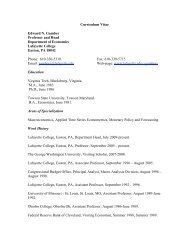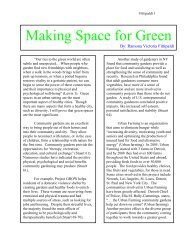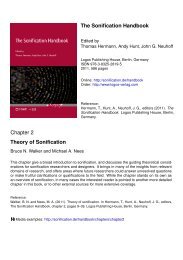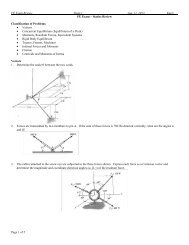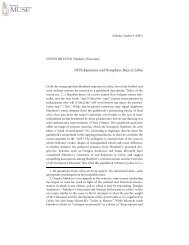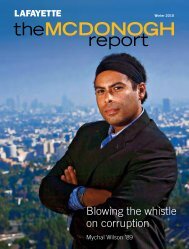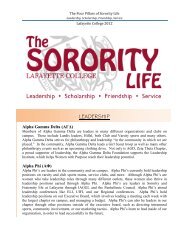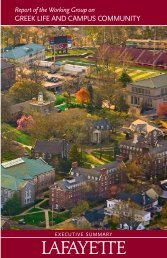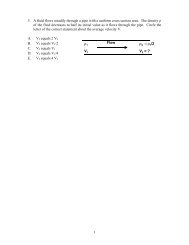2011 - Sites at Lafayette - Lafayette College
2011 - Sites at Lafayette - Lafayette College
2011 - Sites at Lafayette - Lafayette College
Create successful ePaper yourself
Turn your PDF publications into a flip-book with our unique Google optimized e-Paper software.
After more than five decades, Ed Washington ’59 (left) and Jim Vorosmarti Jr. ’57 c<strong>at</strong>ch up on each other’s lives in a very different world from those<br />
early years in the 1950s <strong>at</strong> <strong>Lafayette</strong>.<br />
A few of the upperclassmen brothers continued to<br />
pursue their ultim<strong>at</strong>e goal of striking the discrimin<strong>at</strong>ory<br />
clause from the fr<strong>at</strong>ernity’s constitution. In the meantime,<br />
Vic and I were initi<strong>at</strong>ed into Delta Sigma. . . . we both<br />
were heartened because we knew the brothers had voted<br />
individually, secretly, and unanimously.<br />
Occasionally, our brothers were harassed by students<br />
who disagreed with their efforts to establish open<br />
membership in Phi Kappa Tau and set an example for<br />
all college fr<strong>at</strong>ernities.<br />
We both grew up in the segreg<strong>at</strong>ed South. . . . We<br />
understood wh<strong>at</strong> was happening within Phi Kappa Tau,<br />
but not its total significance. To us, life <strong>at</strong> <strong>Lafayette</strong> was<br />
such a gre<strong>at</strong> step forward.<br />
I left <strong>Lafayette</strong> th<strong>at</strong> year, and only returned once.<br />
Nearly 30 years l<strong>at</strong>er, I found Vic’s phone number in an<br />
Atlanta phone directory and called him. . . . I learned th<strong>at</strong><br />
Phi Kappa Tau had modified its membership policy, had<br />
re-established its rel<strong>at</strong>ionship with the original Alpha<br />
Omicron chapter, and initi<strong>at</strong>ed the active brothers into<br />
the fr<strong>at</strong>ernity. It was then th<strong>at</strong> I first thought to seek<br />
initi<strong>at</strong>ion “one of these days.”<br />
On Sunday, Feb. 1, 2009, more than 50 years after<br />
my college days, my pastor, Dr. Wallace Charles Smith,<br />
delivered a sermon to frame the start of African American<br />
History Month within its spiritual context. He referred<br />
to the struggle for civil rights in America. Not all the<br />
advances were made by the handful of men and women<br />
whose names immedi<strong>at</strong>ely come to mind. Much progress<br />
was made by people who took small steps, people whose<br />
names and accomplishments never appeared in headlines.<br />
I realized th<strong>at</strong> I was one of those people, and th<strong>at</strong> wh<strong>at</strong><br />
Civil Rights<br />
<strong>at</strong> <strong>Lafayette</strong><br />
1800-2010<br />
1824 <strong>Lafayette</strong><br />
<strong>College</strong> founded and<br />
named for the Marquis<br />
de <strong>Lafayette</strong>, anti-slavery<br />
advoc<strong>at</strong>e, supporter<br />
of rights for French<br />
Protestants, promoter of<br />
democr<strong>at</strong>ic revolutions.<br />
1826 Pennsylvania<br />
legisl<strong>at</strong>ure grants<br />
<strong>Lafayette</strong> <strong>College</strong> a<br />
charter but requires<br />
addition of Article VIII,<br />
which guaranteeing<br />
8 ◆ McDonogh report ◆ Winter <strong>2011</strong><br />
th<strong>at</strong> no persons shall<br />
be denied admittance<br />
or opportunity to serve<br />
as president, trustee,<br />
or faculty member on<br />
account of religious<br />
preferences.<br />
1832 <strong>Lafayette</strong><br />
opens with a local black<br />
student, Aaron Hoff, in<br />
the first class.<br />
1836 Additional black<br />
students admitted to be<br />
trained for the ministry<br />
in Liberia.<br />
1838 Two slaves,<br />
David and Washington<br />
McDonogh, are sent<br />
from Louisiana to study<br />
<strong>at</strong> <strong>Lafayette</strong>. They<br />
are freed when they<br />
arrive in the North, but<br />
are subject to much<br />
discrimin<strong>at</strong>ion.<br />
1842 Washington<br />
McDonogh leaves<br />
<strong>Lafayette</strong> and sails for<br />
Liberia with other freed<br />
slaves from Louisiana.<br />
1843 John Bemo,<br />
Seminole Indian and<br />
nephew of Chief Osceola,<br />
enrolled and in residence<br />
for four years. <strong>College</strong><br />
expected to admit 10<br />
Choctaw Indians, who<br />
never m<strong>at</strong>ricul<strong>at</strong>ed.<br />
1844 David<br />
McDonogh is first black<br />
student to gradu<strong>at</strong>e.<br />
1846 Last black<br />
students in residence<br />
for the next 100 years.<br />
1869 <strong>Lafayette</strong><br />
awards honorary degree<br />
to Edward Blyden, noted<br />
Liberian scholar and<br />
diplom<strong>at</strong>.<br />
1870 After a<br />
contingent of female<br />
students from Vassar<br />
<strong>College</strong> visits, the idea<br />
of admitting women<br />
is promoted in the<br />
Easton and <strong>Lafayette</strong><br />
newspapers.


